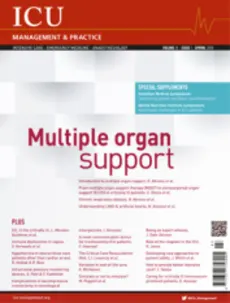Issues
Volume 18 - Issue 1, 2018
Fri, 16 Mar 2018

In this Issue
- Table of contents
- Editorial Board
- Download pdf (print optimised)
- Download pdf (screen optimised)
Editorial
Multiple organ support
READ MOREInterventions intended to support one organ can have unexpected implications on the patient, presenting physicians with critical decisions. These can be aided with innovative technologies and new techniques, but only if well understood. We often come across multiple organ dysfunction syndrome (MODS), with incremental degrees of physiologic derangements in individual organs, which should be seen as a conti...
News
Mindray launches BeneVision N1 for uninterrupted monitoring during patient transport
READ MOREMindray announces the release of the BeneVision N1 Patient Monitor. Designed for the varying demands of both intra and out-ofhospital patient transport, the BeneVision N1 provides a steadfast and versatile solution that integrates seamlessly into the BeneVision Patient Monitoring Solution with maximum mobility, patient-centric data continuity and streamlined workflow. In compliance with out-of-hospital p...
Out with the saline?
READ MORETwo companion studies have shown that use of saline as intravenous fluid therapy, compared to crystalloids, was associated with poor survival and increased risk of kidney complications. Matthew Semler, MD, MSc, assistant professor of Medicine at Vanderbilt University School of Medicine, told ICU Management & Practice in an email: “Because saline and balanced fluids are similar in cost and use of sa...
ICU delirium a distinct indicator of acute brain injury
READ MOREMore than half of ICU patients in a new study experienced delirium for long periods during their stay. Sedative-associated delirium was most common, while longer periods of hypoxic delirium and unclassified delirium were associated with worse cognitive function at follow-up one year after hospital discharge. You might also like: Sedative prevents delirium in ICU patients Patients were assessed for delir...
Gut microbes protect against sepsis
READ MORENew research published in Cell Host & Microbe suggests that gut bacteria may help in the fight against sepsis. In the study, mice were given particular microbes, which increased blood levels of immunoglobulin A (IgA) antibodies, protecting the mice against polymicrobial sepsis. You might also like: Study: Microbiome Disruption May Have Key Role in ARDS, Sepsis There is evidence showing that people w...
Cover Story
Introduction to multiple organ support
READ MOREThere is a renewed interest in novel extracorporeal technologies as a means of supporting individual organ failures. An emphasis should be placed on characterising the spectrum of extracorporeal devices for various organs and understanding how devices intended for support of one organ can have an indirect or direct impact on other organs, which is particularly relevant as different extracorporeal platforms...
From multiple organ support therapy to extracorporeal organ support in critically ill patients
READ MOREThe complex nature of the multiple organ dysfunction syndrome (MODS) requires an integrated supportive therapy. Native organs have a continuous crosstalk and have in common in most cases an altered composition of the blood circulating and perfusing them. In this article we describe the concept of extracorporeal organ support (ECOS) for the treatment of combined organ dysfunction in critical illness. ECOS i...
Chronic respiratory dialysis
READ MOREExtracorporeal carbon dioxide removal is emerging as a potential strategy to manage acute hypercapnic respiratory failure. There may be an opportunity to use similar techniques to manage chronic hypercapnic respiratory failure, in what may be termed "chronic respiratory dialysis", potentially altering the physiological and clinical effects of chronic hypercapnia associated with certain chronic lung disease...
Understanding LVAD & artificial hearts
READ MORERegarding the growing number of patients with long-term mechanical assist devices, intensivists need to understand the physiology of the devices, their functioning, potential complications and their management. Long-term mechanical circulatory support (MCS) is being used increasingly for patients at risk of dying from heart failure and cardiogenic shock (Ponikowski et al. 2016; Gustafsson and Rogers 2017)...
Special Supplement: Hamilton Medical Symposium
Optimising patient-ventilator synchronisation
READ MOREDr. Lluís Blanch, Dr. Jean-Michel Arnal and Prof. Francesco Mojoli discuss why patient-ventilator synchrony is important, how to detect asynchronies, and technical solutions for optimising synchronisation. Patient-ventilator asynchrony occurs when there is a mismatch between the patient’s inspiratory time and the mechanical breath (phase asynchrony) or when the flow provided by the ventilator is ina...
Special Supplement: Nestlé Nutrition Institute Symposium
Nutritional challenges in ICU patients
READ MOREThis symposium explored controversial aspects of the nutritional management of patients in the ICU. There are new concepts and old controversies such as the role of permissive underfeeding and the optimal timing of nutrient delivery. Glucose control is also one such area where there is still no widespread agreement on optimal targets for blood glucose control in ICU. In addition to modulating the provisi...
Glycaemic control in critically ill patients: how tight should it be?
READ MOREThere is still no widespread agreement around optimal targets for glucose control in the ICU: some clinicians maintain that glucose control is unnecessary and harmful, while others claim that blood glucose control is essential to improve prognosis.1-3 Those who favour liberal glycaemic control assert that hyperglycaemia is simply a beneficial adaptation in critically ill patients to provide fuel for vi...
Dysglycaemia in the critically ill
READ MOREAs has been pointed out, the benefits of tight glycaemic control in the ICU have by no means been clearly established or accepted. In 2010 a meta-analysis of seven prospective randomised studies concluded that intensive insulin therapy in mixed ICU patients was not supported by evidence.19 Today we understand that hyperglycaemia, hypoglycaemia, and high glycaemic variability are all associated with poo...
Facilitated glucose control in the ICU through nutrition
READ MOREAs recently as 2010, the view of metabolic requirements for patients admitted to ICU was that all patients had the same metabolic needs and could therefore be managed with the same nutritional product. In general, critically ill patients were fed along the same lines as healthy people in the ratio of around 50% carbohydrates, 35% lipids and 15% protein. However, little benefit has been found from this appr...
The increased recognition of proteins in critical illness
READ MOREThere are many new concepts and old controversies surrounding nutrition in critical care such as: the role of trophic feeding, permissive underfeeding, the use of immune modulating agents, and the optimal timing of nutrient delivery. However, enteral nutrition and protein delivery have consistently been found to be beneficial. Traditionally, the concerns in the ICU were about meeting energy requirements...
Series: Gases
CO2 in the critically ill
READ MORECO2 exerts potent effects on lung biology that could be clinically relevant in critically ill patients, in particular those with acute respiratory distress syndrome (ARDS). The impact of hypercapnia on outcome in these patients is yet to be determined. The physiological effects of hypercapnia are increasingly well understood, but the literature remains confusing. Important insights have emerged regarding...
Point-of-View
Improving diagnostic stewardship by using new microbiological technologies
READ MOREDescribes an episode of sepsis in a leukaemia patient, whose treatment was early guided by using rapid diagnostics technology to identify the cause of infection. A 4-year-old patient under treatment for acute lymphoblastic leukaemia, diagnosed 6 months before, was admitted to the emergency room (ER) at midnight (00h33) due to a fever episode of less than one hour of evolution in the context of neutropaen...
Matrix
Immune dysfunction in sepsis
READ MOREAn overview of the recent advances in the diagnosis and treatment of immune system dysfunction in sepsis. Sepsis is defined as life-threatening organ dysfunction caused by a dysregulated host response to infection (Singer et al. 2016). Sepsis-induced immune system dysfunction is an important sequelae of sepsis. The persistence of immune system dysfunction in the later stages of sepsis increases patients�...
Hypothermia in neurocritical care patients other than cardiac arrest
READ MOREHypothermia (HT) is a cornerstone of neuroprotective strategies and has been used in critical care for acutely brain injured adult patients for many years. This review aims to discuss the clinical evidence supporting the use of HT in neurocritical care patients beyond care after cardiac arrest (CA), such as traumatic brain injury (TBI), acute ischaemic stroke (AIS), non-traumatic intracerebral haemorrhage...
Intracranial pressure monitoring devices
READ MOREIntracranial pressure (ICP) monitoring is the cornerstone for treatment and management of patients, especially following traumatic brain injury (TBI) but also other clinical conditions such as non-traumatic bleeds, hydrocephalus, space-occupying lesions and cerebral oedema. The key target to monitor and treat ICP is to optimise the cerebral perfusion pressure (CPP). CPP is obtained by calculating the diffe...
Complications of decompressive craniectomy in neurological emergencies
READ MOREThere are a number of complications related to the use of decompressive surgery. The most important thing to bear in mind is these complications can impair recovery. Decompressive craniectomy is a surgical procedure where a large section of the skull is removed and the underlying dura mater exposed. Primary decompressive craniectomy refers to leaving a large bone flap out after extraction of an intracran...
Supporting the patient innovator
READ MORETheir inability to communicate effectively whilst he had a tracheostomy on the intensive care unit (ICU), had such a profound impact on Duncan Buckley and his wife, Lisa-Marie, that they developed a concept for a novel interactive communication device, called ‘ICU CHAT’. Together, they have been embedded within the multidisciplinary ICU research team at the Queen Elizabeth Hospital Birmingham (QEHB), s...
Management Matters
The critical care resuscitation unit
READ MOREThe number of clinical conditions which have improved outcomes associated with shorter time to specialised resuscitation and definitive intervention continues to increase. Many of these time-sensitive conditions have improved outcomes at high volume centres, but these centres are also challenged by limited intensive care unit (ICU) availability to reliably accept patients within optimal time windows. The...
Variation in end-of-life care
READ MOREVariability in end-of-life care would seem to demand a standard operating procedure, but a roadmap towards harmonisation arguably would be easier to implement. Mainly due to enormous pharmacological and technological innovation during the last decades, intensive care medicine can help patients survive, whose vital functions are seriously compromised or have failed temporarily. However, still approxi...
“Simulate, or not to simulate?”
READ MOREA brief discussion about the importance and the state of the art of simulation in anaesthesia and intensive care medicine. Training in simulation plays a key role in complex systems such as aviation and the nuclear industry, to investigate predictable errors that lead to adverse outcomes. The advancement made by aviation integrating simulation in training over the past years is relevant, whereas in medic...
Being an expert witness
READ MOREDescribes the practicalities of being an expert witness and explains what qualities are necessary to succeed in this important role. Our legal system couldn’t function without medical expert witnesses. From personal injury claims to criminal prosecutions, there is a constant demand for experienced doctors with the necessary skills and authority to take on this role. But while expert witness work can be...
Establishing a relationship of trust and care
READ MOREThe chaplain is a resource of ethically competent support and a compassionate caring presence for patients, families and ICU staff. An admission to the intensive care unit (ICU) is often a traumatic experience for both patients and families. Although members of the critical care team are specially trained to provide care and treatment requiring close, constant observation, the environment can be overwhelm...
Developing new approaches to patient safety
READ MOREThe International Society for Rapid Response Systems joins with the Patient Safety Congress in July 2018 to develop new approaches to managing patients at risk of deterioration. Identification and treatment of deteriorating hospital patients is a major safety issue and cannot be managed in isolation. This event will bring the issues of the at-risk and deteriorating patient and patient safety closer togeth...
Interview
How to provide better intensive care?
READ MORESystems approach and individualised care Professor Jukka Takala, MD, PhD, is professor of Intensive Care Medicine in the University of Bern, Switzerland, Director and Chief Physician of the Department of Intensive Care Medicine, and Chair of the business unit of Intensive Care Medicine, Emergency Medicine and Anaesthesiology and Pain Medicine at Inselspital, the Bern University Hospital. His research focus...
Caring for critically ill immunocompromised patients
READ MOREWe can do better! Élie Azoulay, MD, PhD, is Professor of Medicine in Specialty Pulmonary Medicine and Critical Care at Saint Louis Teaching Hospital and Université Paris Diderot in France. He is the Director of the medical intensive care unit (ICU). He leads the French programme for the care of critically ill immunocompromised patients, and is part of the national reference centre for thrombotic microang...
Agenda
Upcoming events
READ MOREAPRIL 5-7 14th Emirates Critical Care Conference Dubai, UAE https://iii.hm/hud 12-14 ESICM EuroAsia 2018 Hong Kong https://iii.hm/hue 12-15 14th WINFOCUS World Congress on Ultrasound in Emergency & Critical Care Madrid, Spain https://iii.hm/huf 26-27 15th Annual Critical Care Symposium Manchester, UK https://iii.hm/hug MAY 3-5 ESICM LIVES Forum - Monitoring in ARF Madrid, Sp...









































